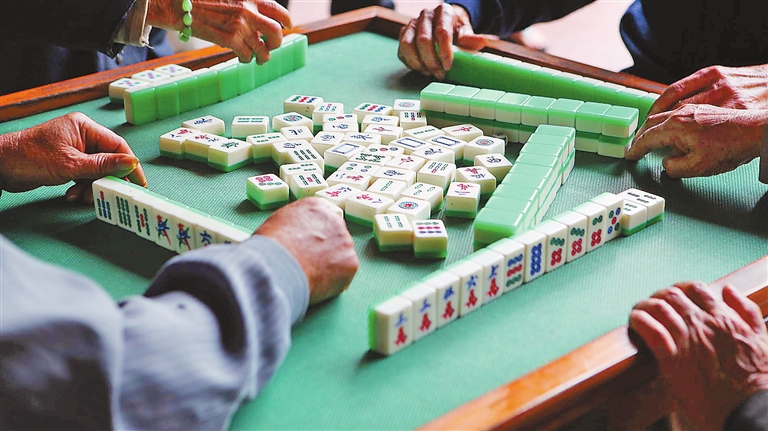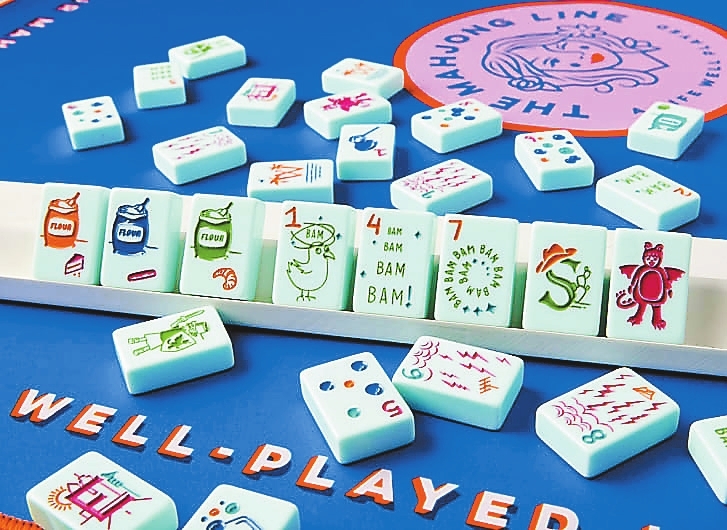

MAHJONG, the centuries-old Chinese tile game, became embroiled in controversy last week over a debate about cultural appropriation. Criticism erupted online over The Mahjong Line, a Dallas-based company founded in the United States, that sells brightly colored tiles with reinvented symbols — bags of flour representing the traditional flower tile, for instance, and the written word “bam” representing the bamboo tile. The artwork featured on traditional tiles, “while beautiful, was all the same,” the company said on its website, adding that “nothing came close to mirroring (the founder’s) style and personality.” The new tiles offered a “respectful refresh” of American mahjong, which differs slightly from traditional Chinese mahjong in its rules and gameplay, the company said. The website has since been changed to remove these phrases. Images of the tiles and screenshots from the company’s website were posted on Twitter last week, sparking an online controversy almost immediately. Social media users, including those from the Asian American community in the U.S., accused the founders of cultural appropriation, disrespectful language and ignorance toward the game’s cultural significance while profiting from it. Each set of the mahjong tiles costs US$325 or US$425. “Please put the Chinese characters BACK onto the Chinese game. Don’t change my history and culture to make it more palatable to you,” tweeted Grace Meng, New York’s first Asian American member of U.S. Congress. By Wednesday last week, the company had apologized and updated its site. “While our intent is to inspire and engage with a new generation of American mahjong players, we recognize our failure to pay proper homage to the game’s Chinese heritage,” it said in a statement. But the company has not stopped selling its games. “We stand by our products and are proud to be one of the many different companies offering a wide range of tiles and accessories for the game of American mahjong,” said co-founder Kate LaGere in a statement to CNN. “That being said, we take full responsibility that in our quest to introduce new tiles we unintentionally recreated an experience shared by many Asian Americans of cultural erasure and are working to correct this mistake.” This is just the latest in a long string of similar incidents that have sparked outrage in recent years. The pattern is familiar now: Someone borrows or misrepresents a piece of Asian culture, becomes the target of online criticism, offers an apology and a promise to do better, and the Twittersphere moves on — until the next controversy. Ongoing debate “When cultures are inspired by another culture, that’s one thing,” said Nancy Wang Yuen, a U.S.-based sociologist and author who writes about race and representation, in a phone interview with CNN. “But if they claim to improve upon and disrespect the original culture, or if there’s an air of superiority over the original content, then that becomes appropriation.” The past few years have seen countless controversies resulting from perceived appropriation in the United States, particularly in the fashion world. In one famous incident in 2018, a White high-school student wore a traditional Chinese qipao (or a cheongsam) dress to a prom in Utah. The backlash was swift, with Chinese Americans tweeting in response, “My culture is not your prom dress.” Celebrities have been called out too: Kim Kardashian West’s lingerie brand, originally named Kimono, was heavily criticized when the star attempted to trademark a specific font version of the word, so much so that she renamed it in 2019. (Kimonos are a traditional Japanese garment that date back centuries.) Soon after, singer Kacey Musgraves was lambasted for taking revealing photos in a traditional Vietnamese ao dai dress. But appropriation and its accompanying controversies take place in other spheres of life, from food and makeup to language and speech. And, Yuen said, it’s most harmful when there’s a power difference between the appropriators and the group they’re borrowing from — a dominant group “denigrating” the minority culture while profiting from it or misrepresenting it, as she put it. The “fox eye” beauty trend went viral in 2020, with people trying to emulate the so-called “almond-shaped” eyes of celebrities like Kendall Jenner — an uncomfortable sting for Asian Americans who received racist taunts in the past for those same facial features. Minority groups can commit appropriation, too — some Asian American entertainers in the U.S., such as singer and actor Awkwafina, have faced criticism for, at times, speaking with a “blaccent” and appropriating African American Vernacular English. Calling out offenders Cultural appropriation itself is nothing new; it’s been happening for centuries. But, increasingly, people are calling it out — partly because of the ubiquity of social media, Yuen said. “With the popularity of social media and the ease of having your voice heard even if you’re not famous — I think that allows for people to comment on and bring attention to practices that have been long standing ... of appropriating non-Western cultures, as well as the native cultures,” she said. Apart from providing a platform for people to voice their opposition, social media also allows the opinions of relatively anonymous characters — say, a teenager in Utah — to be seen and shared by mass audiences, she added. Problematic content that may previously have gone unnoticed can now spread like wildfire. The flip side This rise in activism and cultural sensitivity has been met with skepticism in some quarters. Some have argued that the debate on appropriation stifles innovation and collaboration, pointing to popular fusion cuisines or pieces of art inspired by other cultures. Others have raised questions about cultural ownership and gatekeeping. Mahjong, for instance, doesn’t have just one “correct” form; the game has evolved into different variations played in different communities. American mahjong, the variant that inspired The Mahjong Line, was introduced to the U.S. in the 1920s. The rules were changed and the game became distinctly different from the traditional form played in China. Over the decades, it became culturally significant in different American communities, including among Jewish families following World War II. “Mahjong has been changing ever since it first came on the scene (in China) in the mid-1800s,” said Gregg Swain, an American mahjong expert whose work informed the founders of The Mahjong Line when they launched the company in November 2020. “Versions of the game, and the tile set itself, have been altered to fit into different cultures and regions.” Others have voiced concern that this heightened public awareness could compromise critical nuance, especially when each case depends so much on its individual context. Critics point out the danger of blind outrage becoming a knee-jerk reaction, with social media so easily escalating controversy. Yuen offered another take to these criticisms: Think of it not as “cancel culture,” but “consequence culture.” “I think people are tired of the history of cultural appropriation,” she said. “People are, for the first time, able to voice discontent ... That’s how growth happens.” “The problem is not when (activism) is taken too far,” she added. The problem is when offenders shut down the conversation because they feel attacked, instead of taking the step to recognize their privilege, educate themselves and engage with those minority communities, she said. Besides, she said, most people who call out appropriation aren’t demanding that only Chinese people can play mahjong. (SD-Agencies) | 
